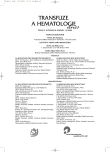-
Medical journals
- Career
Chronic idiopathic myelofibrosis: biological characterization and histological “grading” of the fibrosis with respect to diagnosis and prognosis
Authors: J. Marcinek 1; L. Plank 2
Authors‘ workplace: Ústav histológie a embryológie Jesseniovej lekárskej fakulty Univerzity Komenského v Martine, Slovenská republika 1; Ústav patologickej anatómie a Konzultačné centrum bioptickej diagnostiky ochorení krvotvorby Jesseniovej lekárskej fakulty Univerzity Komenského a Martinskej fakultnej nemocnice v Martine, Slovenská republika 2
Published in: Transfuze Hematol. dnes,12, 2006, No. 2, p. 62-69.
Category: Comprehensive Reports, Original Papers, Case Reports
Overview
Chronic idiopathic myelofibrosis as a part of Ph1-myeloproliferative disorders is characterized by predominant proliferation of granulocytic and megakaryocytic lineages. Initially it remains asymptomatic, latter on the disease shows continual development from early prefibrotic stages with hypercellular bone marrow to the fibrotic stages with variable degree of cellularity, variable amount of myelofibrosis and various morphology of megakaryocytes. They are represented by medium-large to large forms with hyperlobulated dense to dysplastic nuclei, as well as by forms with diagnostically important „cloudy-like“ nuclei. Myelofibrosis representing an secondary event is caused by secondary stimulation of bone marrow fibroblasts by growth factors produced by clonal tumor cells. In the first phase, an increase of reticulin and later on of collagenous fibres can be observed, which is followed in final phases by thickening of the bone trabecules. An inherent part of the diagnostic procedure is represented by trephine bone marrow biopsy examination, attributing to the evaluation of the cellularity and to the grading of myelofibrotic changes. Previously used grading systems were rather heterogenous – the differences were caused by insufficient knowledge of the early prefibrotic stage of the disease, different opinion on the „normal“ amount of bone marrow fibrosis and by variable principles of grading systems. The „descriptive“ systems stressed out the morphologic description of the bone marrow without any objectivisation of the assessment. The quantitative systems graded the disease by evaluation of the bone marrow fibres amount, while the qualitative systems paid attention on a distinction between reticulin, collagen fibrosis and osteosclerosis resp. The semiquantitative systems use a combination approach to evaluate both qualitative and quantitative factors of fibrotic changes. In August 2004 an European consensus on bone marrow fibrosis grading was reached, using a 4-degree semiquantitative system representing a modified version of some previous systems. It allows an objectivisation of the myelofibrosis assessment and defines the „normal“ fibrosis of bone marrow as MF0. It also recognizes a mild reticulin fibrosis as MF1, moderate reticulin fibrosis with incipient collagen fibrosis as MF2 and advanced collagen fibrosis as MF3. Osteosclerosis is included within the MF2 and MF3 stages. This grading system seems to represent a simple and reproducible system, which might be applied also for the secondary bone marrow fibrosis – therefore it is to be recommended for a daily routine diagnostic practice.
Key words:
chronic idiopathic myelofibrosis, grading, histopathology, bone marrow
Labels
Haematology Internal medicine Clinical oncology
Article was published inTransfusion and Haematology Today

2006 Issue 2-
All articles in this issue
- Is WT1 gene hyperexpression a malignant cells marker?
- Hemorrhagic complications during warfarin therapy
- Non-invasive prenatal diagnosis from maternal peripheral blood is performed on fractionated extracellular fetal DNA with size < 500 bp
- Idiopathic thrombocytopenic purpura in pregnancy refractory to immunosuppressive treatment – case report
- Anagrelide in the treatment of thrombocytosis in myeloproliferative disease – case report
- B-cell chronic lymphocytic leukaemia
- Chronic idiopathic myelofibrosis: biological characterization and histological “grading” of the fibrosis with respect to diagnosis and prognosis
- TEL/AML1 increases sensitivity of leukemia cells to L-Asparginase by induction of metabolic stress
- Transfusion and Haematology Today
- Journal archive
- Current issue
- Online only
- About the journal
Most read in this issue- Chronic idiopathic myelofibrosis: biological characterization and histological “grading” of the fibrosis with respect to diagnosis and prognosis
- Anagrelide in the treatment of thrombocytosis in myeloproliferative disease – case report
- Hemorrhagic complications during warfarin therapy
- Idiopathic thrombocytopenic purpura in pregnancy refractory to immunosuppressive treatment – case report
Login#ADS_BOTTOM_SCRIPTS#Forgotten passwordEnter the email address that you registered with. We will send you instructions on how to set a new password.
- Career

